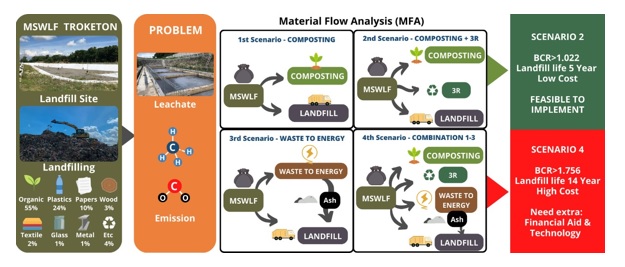Document Type : ORIGINAL RESEARCH ARTICLE
Authors
1 Environmental Engineering and Management Study Program, College of Vocational Studies, IPB University, Kumbang 14, Bogor, West Java, Indonesia
2 Natural Resources and Environmental Management Study Program, Graduate School, IPB University, IPB Baranangsiang Campus, Bogor, West Java, Indonesia
3 Department of Agroindustrial Technology, Faculty of Agricultural Engineering and Technology, IPB University, IPB Dramaga Campus, PO Box 220, Bogor, West Java, Indonesia
Abstract
BACKGROUND AND OBJECTIVES: Waste remains an issue in tandem with the development of the local community. The quantity of waste that is stockpiled in the landfill impacts the amount of leachate, resulting in emissions and reduced landfill capacity. The main challenge for its management is choosing the most cost-effective method to minimize leachate and emissions and increase the amount of waste that is stockpiled, resulting in a longer service life of the landfill. This study aimed to select the treatment at a landfill site.
METHODS: Field observations and sampling of waste composition were carried out at the Klaten Regency. Waste composition sampling was carried out over several years. Material flow analysis was used to calculate the amount of leachate, emissions, and waste in the landfills. The effectiveness and benefits of the treatment scenarios were compared.
FINDINGS: The waste consists of 55 per cent organic, 24 per cent plastic, 10 per cent paper, 3 per cent wood, 2 per cent cloth, 1 per cent glass, 1 per cent metal, and 4 per cent others. The processing scenarios were determined based on this composition. Four prospective scenarios were identified: 1) waste processing with composting; 2) composting and reuse, reduction, and recycling; 3) waste to energy; and 4) the combined process of scenarios 1 – 3. All treatments carried out can reduce leachate by 5.09 – 14.32 per cent, emissions of 11.31 – 44.48 per cent, waste 14.13 – 65.97 tons/day in the landfill, and can extend the service life of the landfill by 3 – 14 years.
CONCLUSION: Material flow analysis was used to calculate the waste processing, emission rate, and leachate production from the four processing scenarios. The reduction of leachate and emission was affected by the treatment used. Combined processing (scenario 2 or 4) can reduce leachate and emissions and extend service life. The selected processing alternative must also consider the benefit-cost ratio. Scenarios (2) and (4) have a benefit-cost ratio of more than 1, which means that the processing is feasible to implement. Scenario 4 has a higher investment cost; so, the scenario that can be applied to the Troketon landfill is scenario 2 with a small investment cost, capable of reducing polluters, extending the landfill's service life to more than 4 years, and a benefit-cost ratio of more than 1.
Graphical Abstract
Highlights
- Waste management in each region can be differ. One of them is influenced by the composition of the generated waste;
- The right treatment to manage waste in the final disposal can be selected based on the dominant waste composition produced;
- These results indicate that processing affects the emissions and leachate produced. Emissions and leachate can be calculated using mass flow analysis simulations;
- The selected treatment can reduce the capacity of the landfill used, hence, it can extend the service life of the landfill life.
Keywords
Main Subjects
OPEN ACCESS
©2023 The author(s). This article is licensed under a Creative Commons Attribution 4.0 International License, which permits use, sharing, adaptation, distribution and reproduction in any medium or format, as long as you give appropriate credit to the original author(s) and the source, provide a link to the Creative Commons license, and indicate if changes were made. The images or other third party material in this article are included in the article’s Creative Commons license, unless indicated otherwise in a credit line to the material. If material is not included in the article’s Creative Commons license and your intended use is not permitted by statutory regulation or exceeds the permitted use, you will need to obtain permission directly from the copyright holder. To view a copy of this license, visit: http://creativecommons.org/licenses/by/4.0/
PUBLISHER NOTE
GJESM Publisher remains neutral concerning jurisdictional claims in published maps and institutional affliations.
CITATION METRICS & CAPTURES
Google Scholar | Scopus | Web of Science | PlumX Metrics | Altmetrics | Mendeley |
CURRENT PUBLISHER
GJESM Publisher



Letters to Editor
[1] Letters that include statements of statistics, facts, research, or theories should include appropriate references, although more than three are discouraged.
[2] Letters that are personal attacks on an author rather than thoughtful criticism of the author’s ideas will not be considered for publication.
[3] Letters can be no more than 300 words in length.
[4] Letter writers should include a statement at the beginning of the letter stating that it is being submitted either for publication or not.
[5] Anonymous letters will not be considered.
[6] Letter writers must include their city and state of residence or work.
[7] Letters will be edited for clarity and length.
Send comment about this article